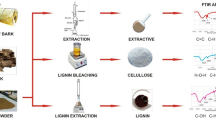Abstract
After enzymic hydrolysis of polysaccharides in milled wood or pulp the unhydrolysed lignin residue becomes soluble in certain polar solvents. Extensive disintegration of the wood is necessary to obtain a sufficient accessibility toward the enzyme. For milling a porcelain rotary ball mill is recommended. A relationship has been found between the milling energy, which is proportional to the size of the mill, the milling time, and the yield of ball-milled wood lignin (BMWL). Enzymatically isolated lignin (EIL) requires a critical milling time which is shorter than that for obtaining maximum yields of BMWL. A procedure for isolation of the total lignin content from wood and pulps in the form of three fractions has been developed, giving a water soluble, low molecular carbohydrate-lignin complex by water extraction of ball-milled wood, a BMWL-carbohydrate complex by subsequent extraction with dioxane, and a EIL-carbohydrate complex by dioxane extraction of the residue after enzymic hydrolysis.
Similar content being viewed by others
References
Azhar, R. M.; Polčin, J.; Rapson, W. H. 1971. Characterization of enzymatically isolated lignin. Paper presented at the Annual Meeting of TAPPI, New York, Febr. 21–25
Bezúch, B.; Polčin, J. (1978. structural studies of EIL from hardwoods. Papir a celul. 33: 29–32
Björkman, A. 1956. Studies on finely divided wood, 1. Svensk Papperstid. 59: 477–485
Brauns, F. E. 1952. The chemistry of lignin. Academic Press, New York
Brauns, F. E.; Brauns, D. A. 1960. The chemistry of lignin. Suppl. Vol. Academic Press, New York, 62–66
Brownell, H. H. 1965. Isolation of milled wood lignin and lignin-carbohydrate complex. Tappi 48: 513–519
Chang, H-M.; Cowling, E. B.; Brown, W.; Adler, E.; Miksche, G. 1975. Comparative studies on cellulolytic enzyme lignin and MWL of sweetgum and spruce. Holzforschung 29: 153–159
Košikova, B.; Polčin, J.; Dandarova, M.; Budiska, E. 1968. The study on molecular grinding of spruce wood with regard to liberation of lignin. Drev. výsk. 1: 25–35
Lai, Y. Z.; Sarkanen, K. V. 1971. Isolation and structural studies. In: Sarkanen, K. V., Ludwig, C. H. (Eds.). Lignins. Wiley-Interscience, New York, 165–240
Pew, J. C. 1957. Properties of powdered wood and isolation of lignin by cellulytic enzymes. Tappi 40: 553–558
Pew, J. C.; Weyna, P. 1962. Fine grinding, enzyme digestion, and the lignin-cellulose bond in wood. Tappi 45: 247–256
Polčin, J.; Bezúch, B. 1973. Enzymatic isolation of lignin, Part I. 14–58. Rep. PPRI, Bratislava
Polčin, J.; Bezúch, B. 1977. Investigation on enzymic hydrolysis of lignified cellulosic materials. Wood Sci. Technol. 11: 275–290
Shubert, W. J. 1965. Lignin Biochemistry. Academic Press, New York. 8–12, 78–117
Somogyi, M. 1952. Notes on sugar determination. J. Biol. Chem. 195: 19–23
Wayman, M.; Obiaga, T. I. 1974. Molecular weights of milled-wood lignins. Tappi 57: 123–126
Author information
Authors and Affiliations
Rights and permissions
About this article
Cite this article
Polčin, J., Bezúch, B. Enzymic isolation of lignin from wood and pulps. Wood Sci. Technol. 12, 149–158 (1978). https://doi.org/10.1007/BF00350820
Received:
Issue Date:
DOI: https://doi.org/10.1007/BF00350820




